Tashkent
Tashkent Guide
Tashkent is the capital and largest city not only of Uzbekistan but of the whole Central Asia. It is a home for more than 2,4 million people. Tashkent is located in the northeastern part of the country along the Chirchik River, at an altitude of 480 m above the sea level. It is one of the oldest cities in Central Asia and the history of the city goes back more than 2000 years. Tashkent is a metropolitan, multi-ethnic city and a home to Uzbeks, Tajiks,Kazakhs, Kyrgyz descendants of Mongol nomads, Armenians and of even some green-eyed, red-haired heirs of Alexander the Great’s armies.
The city has both old and new and has invested a lot in public places like squares, parks and fountains. Tashkent is a dynamic city which is developing faster than ever after the more open new regime stepped in after Islam Karimov’s era. The offering of good restaurants, including several international cuisines, is also growing rapidly and coffee shops can be found in almost every major street. Prices in Uzbekistan are in general very affordable and the city is very clean and safe. Recently, Tashkent has also started to gain name as an architecture destination combining Soviet, Medieval and especially fine new architecture. Tashkent is included in most of our Uzbekistan Tours and Central Asia Tours.
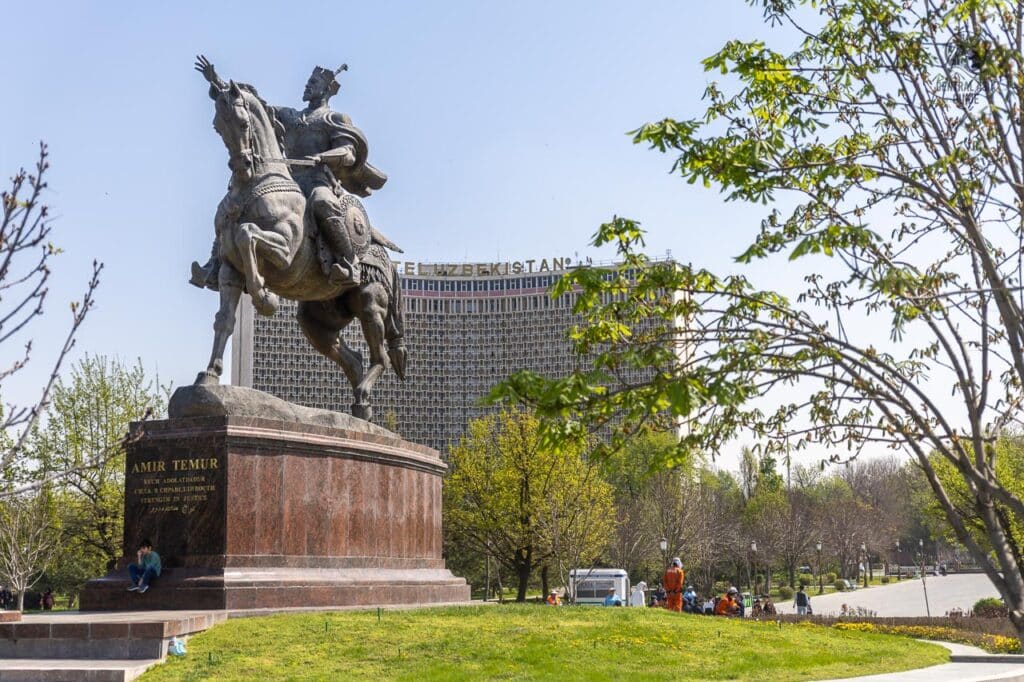
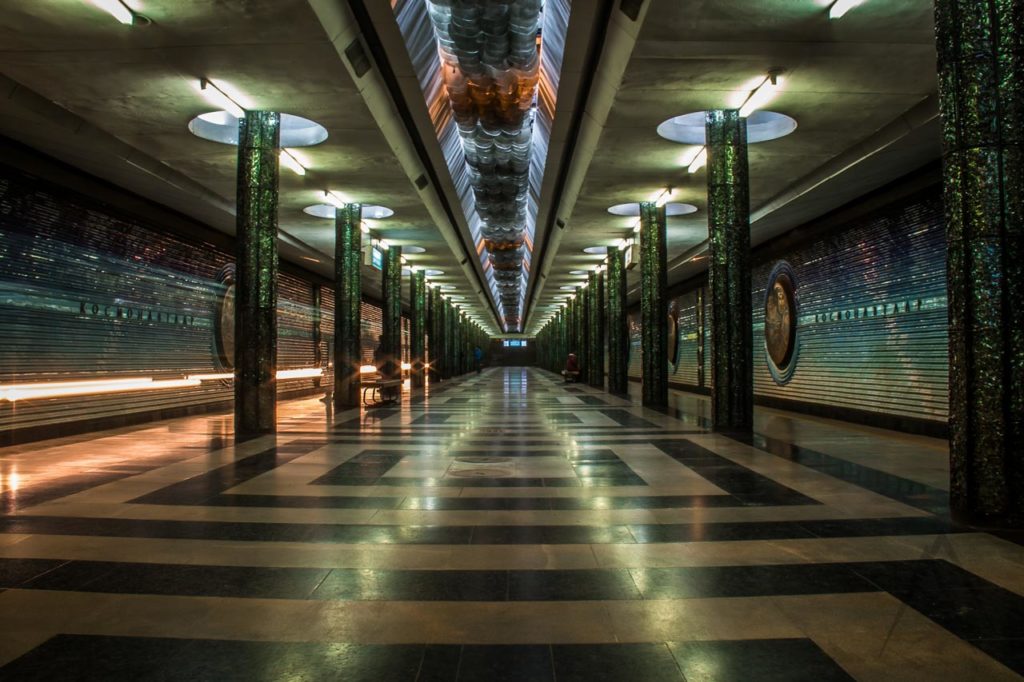
Table of Contents
History of Tashkent
The first mention of Tashkent in chronicles is found in the 2nd century BC under various names: Shash-tepa, Chach-tepa, Shi, Zheshi and Yueni. It was a thriving trading city on the Great Silk Road from China to the Mediterranean. The invasion of the Arabs in the 8th century turned it into ruins. The army under the green banner of the Prophet Muhammad defeated the Zoroastrianism here and established Islam as the dominant religion in the area.
During the 11th century, the name Tashkent appeared, which means a “Stone City”, as from Uzbek “tosh” is translated as stone. In the Middle Ages, the city was a part of the empire of Timur (Tamerlane). At the end of the 18th century, the government Yunuszha proclaimed the city and vast lands in the district as the Tashkent state, but it did not last long and was defeated by the neighboring Kokand Khanate which was then later defeated by the Russian army. Tashkent was surrounded by a fortress wall that had 12 gates with some of them named according to the city the road from the gate was leading to, such as Samarkand or Kokand. Sadly, none of the original gates have survived but there are plans to reconstruct the Tashkent gates by 2026.
The modern history of Tashkent starts in the late 18th century again with the rise in trade but this time from tsarist Russia. On April 26, 1966, an earthquake with the magnitude of 7.5 destroyed the city almost totally. Only very few historical buildings, mosques and mausoleums from old Tashkent survived the earthquake.
The whole world helped to rebuild Tashkent, the architects and engineers from almost all countries of the former USSR were sent to assist Uzbekistan and consequently many of them finally settled in the hospitable city. As a result, Tashkent was rebuilt within the next three years. As Tashkent was part of the Soviet Union, Stalin’s mass relocations brought Koreans, Volga Germans, and Crimean Tatars to the city. The results of this reconstruction can be seen very well in a lavish amount of Soviet style buildings and exceptional Soviet architecture and mosaics.
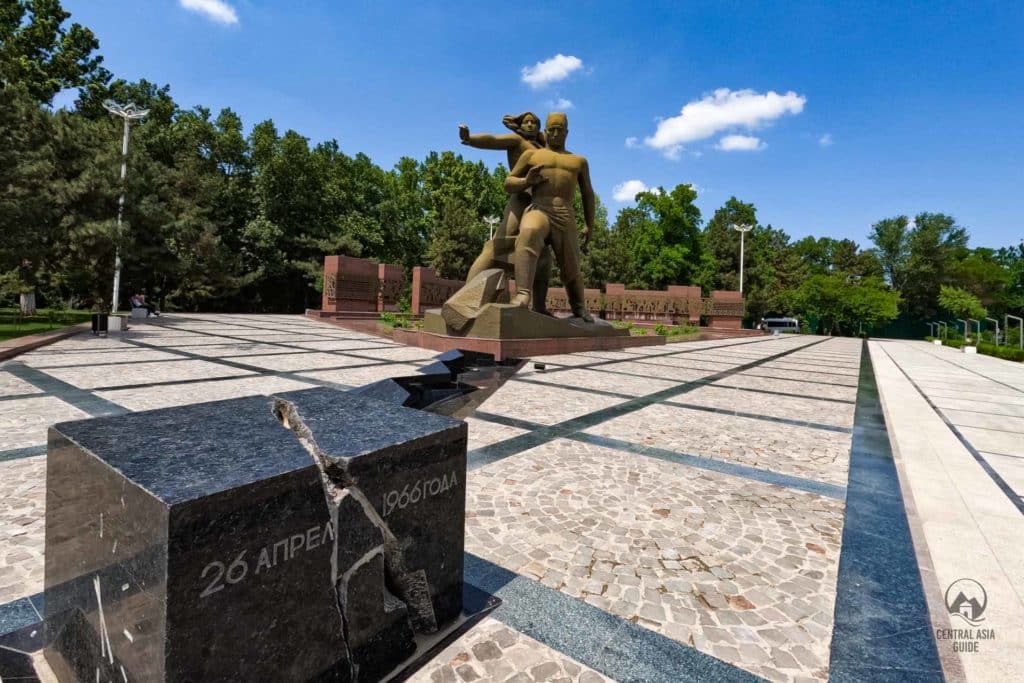
Today, the streets of Tashkent are full of greenery and monuments of a rapidly developing Central Asian power. The sleeping areas still remind from the past with Soviet style apartment blocks. Until 2019, Uzbekistan remained a rather closed country, but with the coming to power of the new president at the end of 2016, tourism and the urban environment have taken a leap forward.
Must see Sights in Tashkent
Tashkent TV Tower
TV tower is located on Amir-Temur street 109. If you like observation platforms, this is the place for you. Tashkent TV tower is the third highest on the territory of the post-soviet countries rising up to 375 meters. It is best to visit the TV-tower an hour before the closing time as Tashkent is especially beautiful during the sunset.
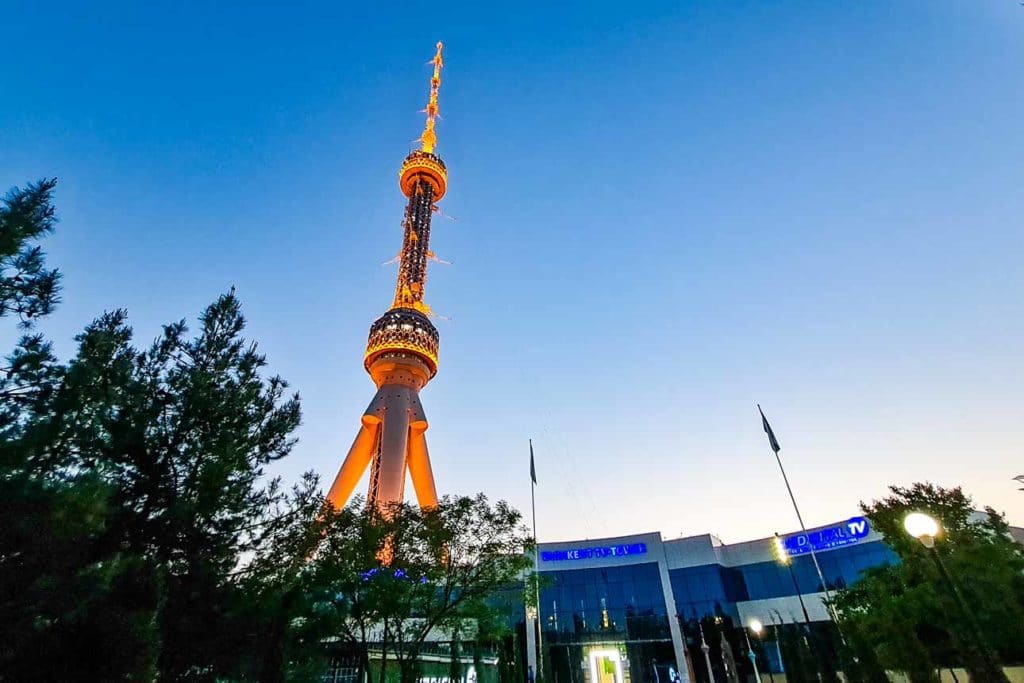
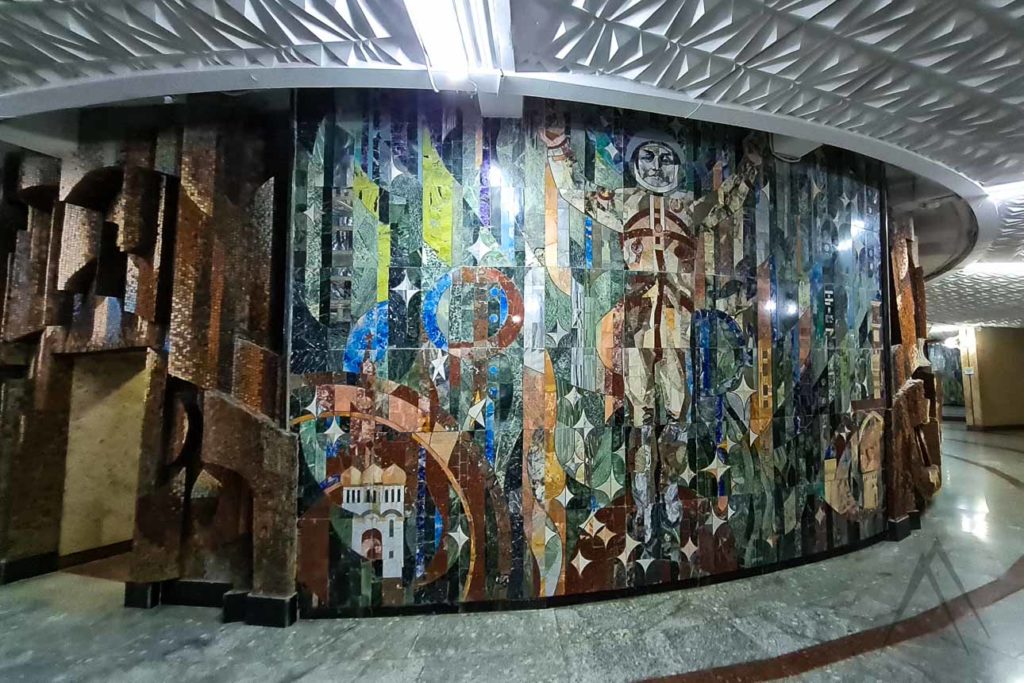
Walk in the Old Tashkent
Tashkent Old Town has shrunk in the near past significantly but the parts that remain, have preserved much of their old charm, little houses with shady courtyards, narrow winding streets and many ancient mosques and madrassas. The Tashkent Old Town starts behind Chorsu Bazaar to the North and is is mostly narrow dirt streets lined with low mudbrick houses and dotted with mosques and old madrassas. If you want to see the real Uzbek capital city life, you can come here to the heart of the old city. In this area, you can still find part of the unique old atmosphere, a genuine picture of how the city lived for centuries before.
Tashkent Squares
Amir Timur Square
Amir Timur or Tamerlane is a name that you should remember while visiting Tashkent. Since independence, the powerful 14th-century conqueror Amir Timur has taken an enormous stature in Uzbekistan. Ex-president Karimov chose Timur as the ancestral figurehead for his newborn country, rewriting its identity and breaking free from its Soviet regime.
Amir Timur square is possibly the most popular place within the local youth, in the evening groups of young people hang around the square. In the middle of the square sits a monument of the Timur presiding over an eponymous horse. Previously, this spot was occupied by Karl Marx. Checking the Timur’s statue at the very center of Tashkent is a must, particularly to see how revered he is by the Uzbek youth who frequently take photos of themselves next to the statue.
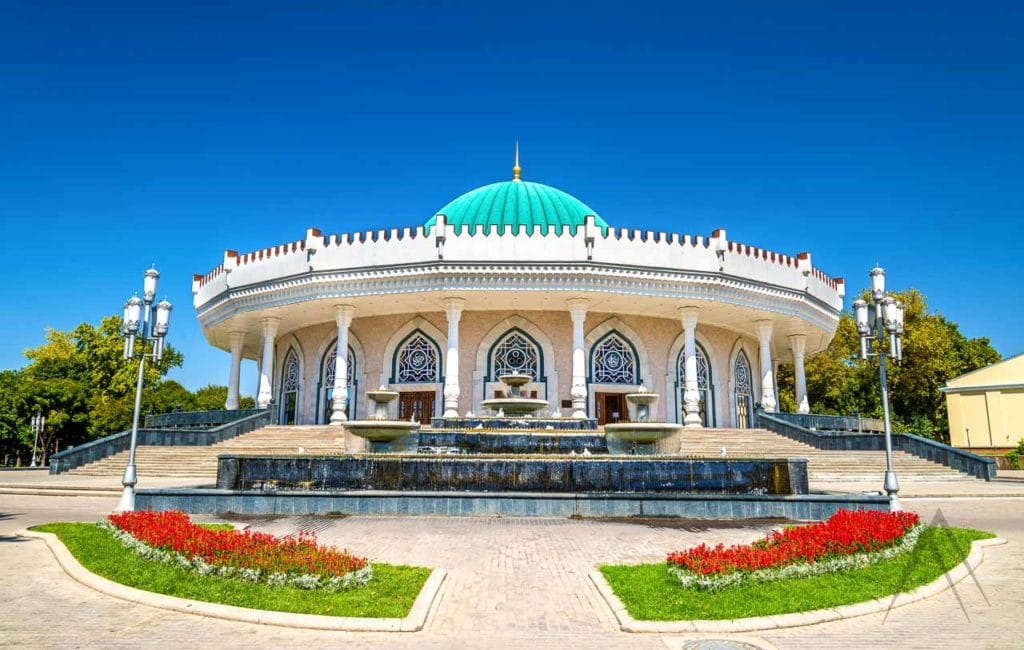
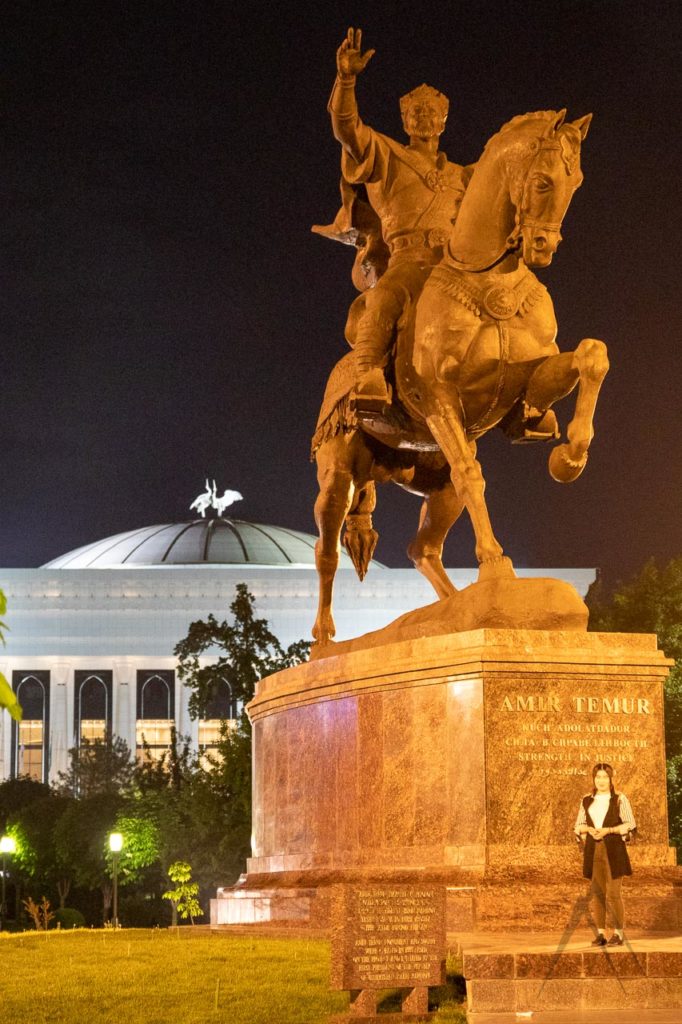
Tashkent Independence square
Independence square, which is also called the Mustaqillik Maydoni, represents the modern squares of Tashkent. The square was formerly named the Lenin square but was renamed in 1992 following the independence of Uzbekistan. At the center of the park there is a globe monument representing the independence of Uzbekistan and below it a statue of a woman representing the motherland.
A square is actually a somewhat misleading name as the area is more like a park with geometric shapes and fountains surrounded by numerous administrative and cultural buildings and monuments including the arch of independence, the senate building and having nearby also the old Romanov palace which now serves as the reception house of the ministry of foreign affairs of Uzbekistan. From the Northern side, the park is met by the Memorial square of WW2 and the large park area around it. The independence park or square offers sights to be seen for hours or even for days with its neighbors and is a showcase of the wealth of modern Uzbekistan. Not all of the area is open to visit currently.
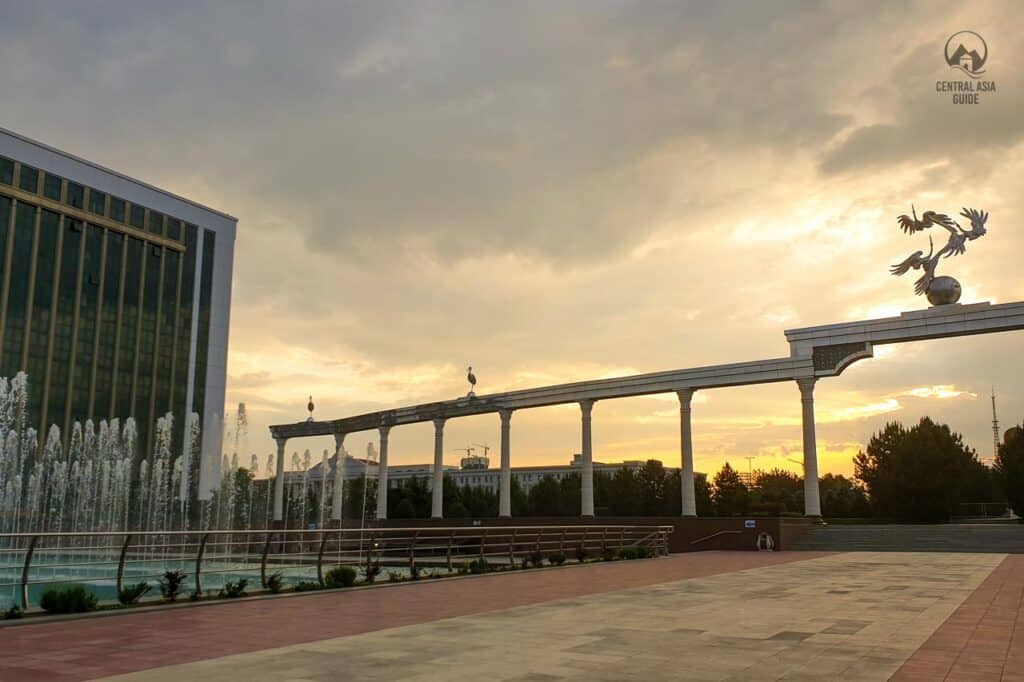
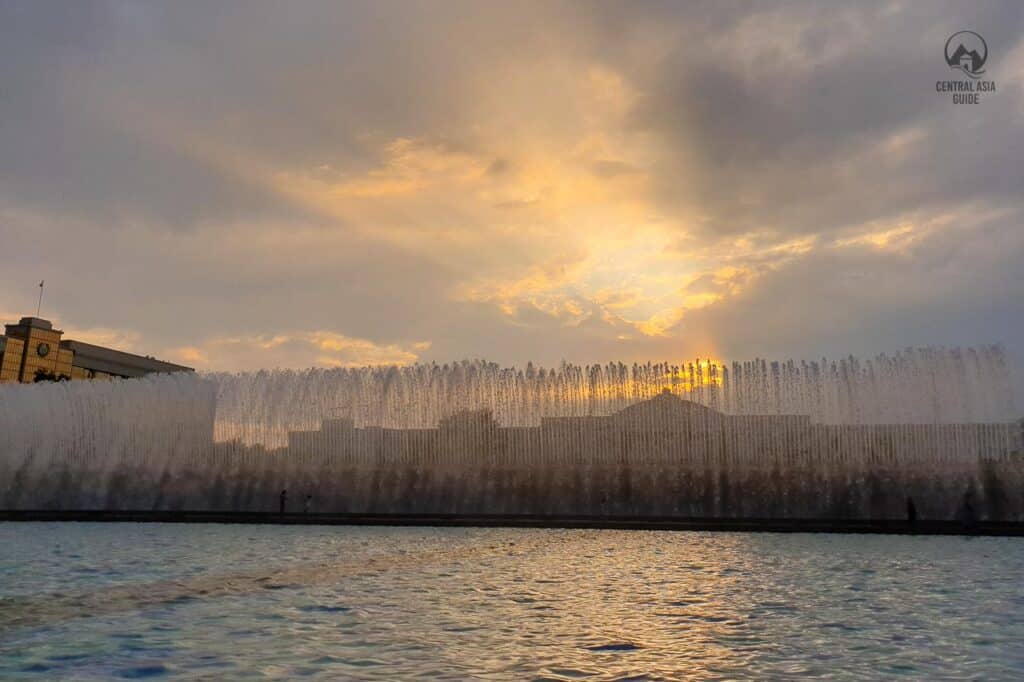
Other sights in Tashkent
Kukeldash Madrasah
Throughout its existence, Mercede Kukeldash served as a fortress and a hotel and has survived two powerful earthquakes. Today, the Kukeldash Madrasa has returned back to its original duty and operates as an Islamic educational institution like back in the 4th century when it was first built.
Tashkent Religious sights
Sheikhantaur Memorial Complex
The memorial complex of Sheikh Khovandi Tahur (Sheihantaur) who lived in the 14th century, includes three buildings: the tomb of Sheikh Taur (15-19th century), the tomb of Kaldirgoch-Biy (15 century), and the mosque.
Zangi-Ota Complex
Zangi-Ota complex has risen around the Timurid-era mausoleum of Zangoita. The person buried in the complex was a 13-century Sufi saint and a shepherd who is still believed to have healing powers.
Hazrati Imam Complex pilgrimage site in Tashkent
Khast Imam Square is the religious heart of Tashkent. After the bustle of the central bazaar it is a good place for relaxation. You will find this place in the old town, among the streets of adobe houses. You can spend few hours here, sitting on the steps in front of the library, watching the children skillfully fly the kites. The square is surrounded by beautiful buildings and gardens, designed in the style of 16th-century architecture.
While you are going to Khast-Imam, you can also explore the houses in the old town. Take a walk into the neighboring streets and go deeper into the passages between houses. The atmosphere here is calm and the houses form a kind of clay labyrinth. While slowly walking, serenity and silence reign, and aromas of local cuisine can fill your nose from the courtyards. You might have a chance to find the most delicious homemade samsa in the city here.
Suzuk-ota complex
Suzuk ota complex is located in the southwestern outskirts of Tashkent. It is an architectural complex dedicated to the noble mentor of all artisans. Suzuk ota was known throughout Tashkent and even beyond due to his talents, the ability to rally the people, and beneficent deeds, which caused great respect among the local residents.
The Suzuk-ota complex consists of a mosque and a mausoleum built during the reign of Amir Temur in 1392. The complex was mainly reconstructed in 2019.
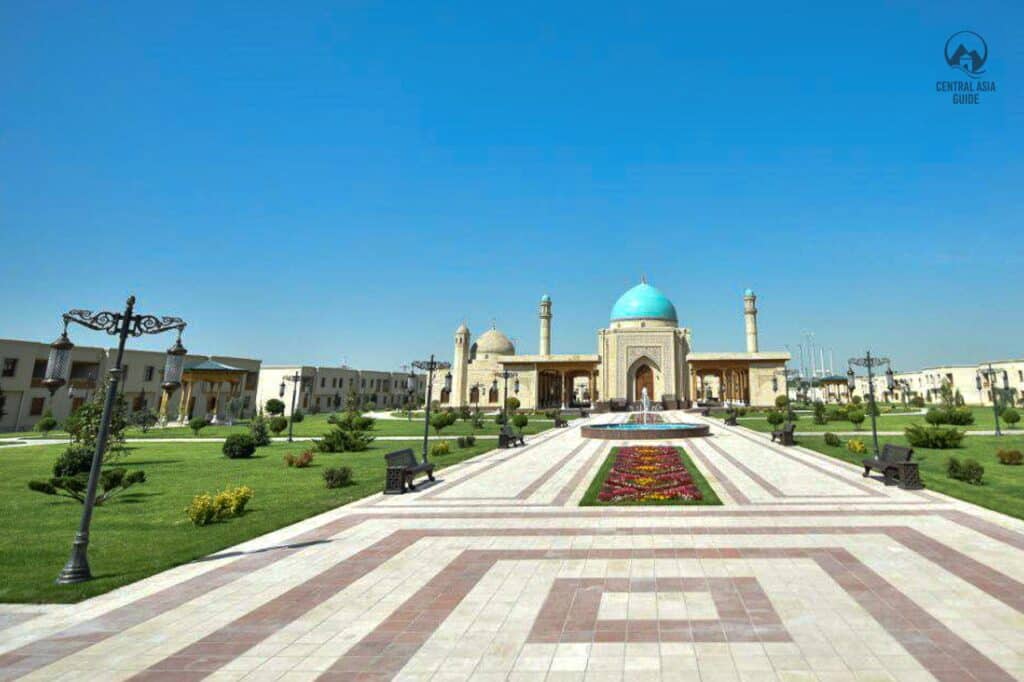
Tashkent Monument of courage - Earthquake memorial
A major earthquake wiped out a large part of Tashkent April 26, 1966 at 05: 23 by local time. As a result of the earthquake, countless buildings and homes were destroyed, the center of Tashkent taking the biggest hit. More than 300,000 people were left homeless and forced to live in tents.
All the Soviet republics of the time rushed to help and started a project to rebuild what was destroyed and to make Tashkent a model city of the Soviet Union. In honor of this event, on May 20, 1976, the monument “Courage” was erected in Tashkent. The monument was created by the sculptor and artist Dmitry Ryabichev with the main idea being friendship, fortitude and courage of people. The artistic image is represented by a black cube made of granite. It shows a dial with a clock, the date and year of the tragedy, through which the split passes, symbolizing the earthquake.

Tashkent new architecture
Tashkent is growing rapidly (while also at the same time destroying lots of old mahalla type single store areas) and the new rule is investing heavily in architecture of the new housing and other buildings. Tall buildings are climbing towards the skies in several locations of the city and well designed monuments constantly appear in different parts of Tashkent. It is apparent that Tashkent will soon surpass Astana as the high rise capital of Central Asia.
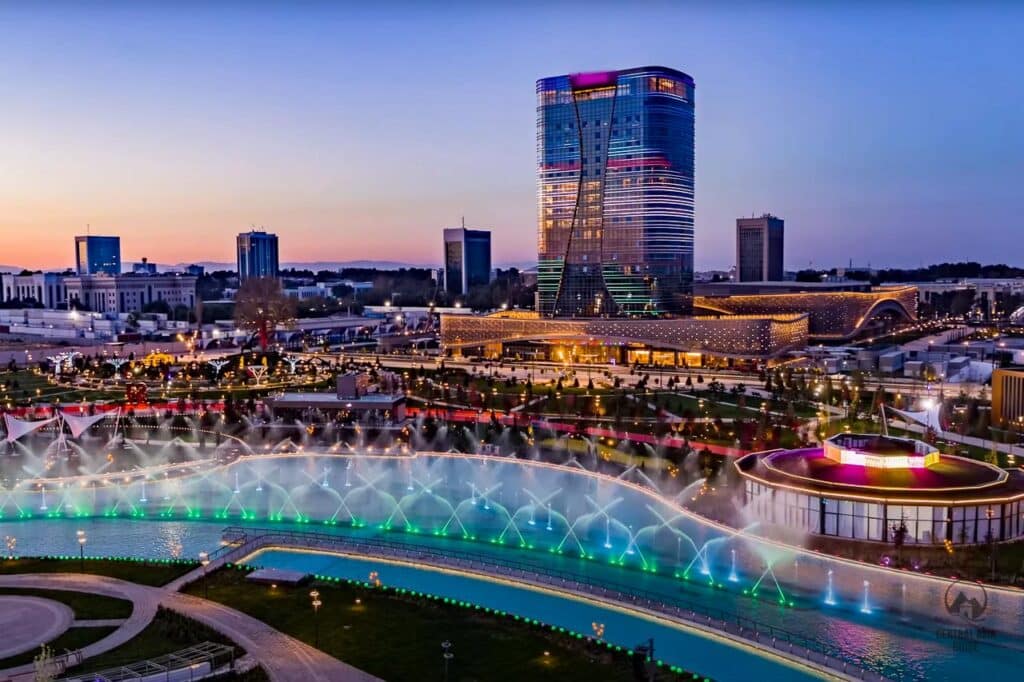
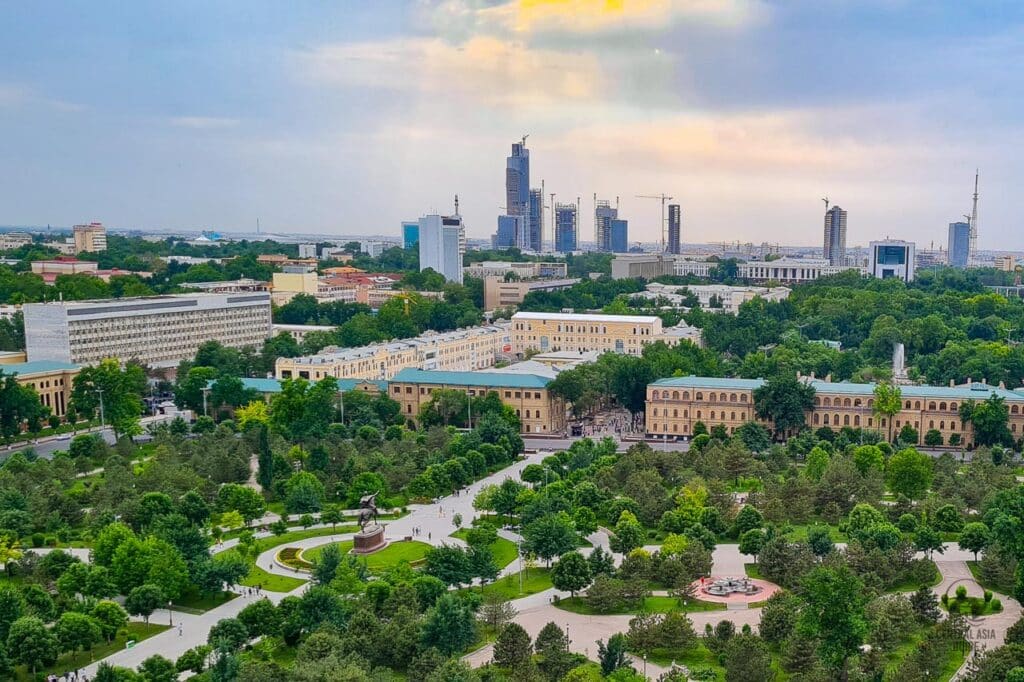
Tashkent With Kids
Tashkent Zoo
Tashkent Zoo is one of the most popular entertainment locations for kids in Tashkent. The first zoo in Tashkent was founded already in 1924. In 1997, the zoo moved to a new location. Today there are 12 animal exhibitions with a petting zoo open for the public. There are several open-air cages for animals, including large winter rooms. There are also artificial reservoirs and fountains, waterfalls and a water channel, a large pond with a beautiful bridge, as well as numerous places for recreation and animal sculptures in a cozy green area. The entrance fee is about 15000 sum for kids and 25000 sum for adults.
Tashkent-Land Amusement park
The amusement park “Tashkent-Land” also known as “Tashkent Disneyland” is located in the walking part of the city not far from the TV Tower. Tashkent-Land was opened in 1997, at the same time as the water park next to it. The entrance to the children’s park is designed in form of a fabulous fortress gate leading to the world of adventure and joy. In addition to the amusement park, there is also a water park with several pools and various slides nearby a beautiful Japanese garden with unique plants as well as a 1.5 km long cable car ride.
Tashkent Circus
From the early ages different genres and styles of the national circus training, including circus-taming, clowns, rope-walking, and others existed in Uzbekistan. The rise of the Uzbek national circus is related to horse riding sporting, military exercises, national games, and the way of life of the local inhabitants. The modern circus arrived in Uzbekistan more than 100 years ago, at the end of the 19th-beginning of the 20th century, while the first circus assemblies from Russia and European countries came on tour to the Turkestan.
The portable circus tents were erected in Tashkent, Samarkand, Andijan, Ferghana, Urgench as well as in the other towns. In 1819 in Tashkent was built the first permanent circus by entrepreneur F.A. Yupyatov, however, in 1966 earthquake destroyed it. During the years of operation the Republican Association “Uzbekgostsirk” turned into a real creative house, making new ways of development. Twenty thematic circus shows, one hundred new numbers and ten big attractions were built during these years. During national festivals, fairs and bazaar shopping days, illusionists and magicians, and different street performers demonstrated their art.
The Uzbek circus has become a full member of the world circus community: the artists of the circus have carried the flag of independent Uzbekistan through the arenas of more than thirty countries of Europe, Asia and Africa. Also, circus artists of our country have participated in prestigious international festivals in France, Germany, Russia, China, UAE where they were awarded the highest prizes.
For instance, in 1996 the participants of the number “Acrobats on Camels” under the guidance of E. Arzumanov won the third place of honor “Bronze Bear” and in 1999 the artists of the number “Horsemen of Uzbekistan” under the guidance of K.Karaev were the second at the International Circus Festival in UAE, Dubai. The representatives of the oldest circus dynasties – the Tashkentbaevs and the Zaripovs – continue their creative work successfully. The honored artist of the USSR and Uzbekistan Khakim Zaripov trains new performers for the number “Horsemen from Sunny Uzbekistan”.
Around Tashkent
Solar Institute in Parkent
Ancient Settlements of Tashkent
The glorious age of the city is defined by artifacts found on the sites of excavations. Tashkent has preserved some intriguing sites of ancient settlements such as Ming Urik, Aktep, Shashtepa Hillfort and impressive Kanka.
Ugam-Chatkal National Park
The closest mountains to Tashkent lie 80 km East from the city and in the mountains the Ugam-Chatkal national park. The mountain range is relatively low (by Central Asian standards), the average height of the mountains is 1500 meters. However, they are considered as one of the best places for winter holidays in Central Asia. The park is full of trails for skiers and hikers with good conditions for mountaineering. In summer, the meadows with flowers are amazingly beautiful.
Chervak Reservoir
After the earthquake in 1966, there was an urgent need for cheap energy in Uzbekistan. In order to ease the situation, Uzbek authorities decided to construct the Charvak State Power Plant. The dam with 168 meters height, formed a blue, picturesque mountain lake called the Chervak reservoir. As a bad side, these beautiful waters have hidden important archaeological sites as once there were ancient settlements at the current bottom of the lake.
Travel to Tashkent
Tashkent by airplane
If you are coming from Europe or US most likely you will get a connection through the airports of Almaty, Istanbul or Moscow. However, if you are coming from the Middle East or Southeast Asia as well as other CIS countries where Uzbekistan Airways operates, there are also a considerable amount of straight flights. In addition there are low-cost airlines like Belavia that flies through Minsk. Tashkent International Airport is the main aviation hub for Uzbekistan. It is located 12 km South from the center of Tashkent. The airport has two terminals: International and domestic.
The international airport building was rebuilt in 2001 although the facilities are dated considering the current level of airports internationally. There are no special express trains, but public transport offers at least two options with bus 10 and minibus 7. Most foreigners choose the taxi to travel to and from the airport.
Terminal 3, which operates the domestic flights was opened in 2011 with a capacity of 400 passengers per hour. The two terminals are separated by the runway, claiming passengers transiting from international to domestic flights and vice versa to exit the airport to transfer between them.
The online timetable of the Tashkent International airport can be checked from the Uzbek airways maintained page.
Tashkent by Train
Tashkent main railway station is located Southeast from the city center. You can arrive to Tashkent by rails from Kazakhstan, Tajikistan or Turkmenistan and from Kyrgyzstan through Kazakhstan. The Tajik-Uzbek rail border seems to be rather erratic especially considering foreign travelers. There are also four trains a week operating between Moscow and Tashkent with about 66 hours of travel time.
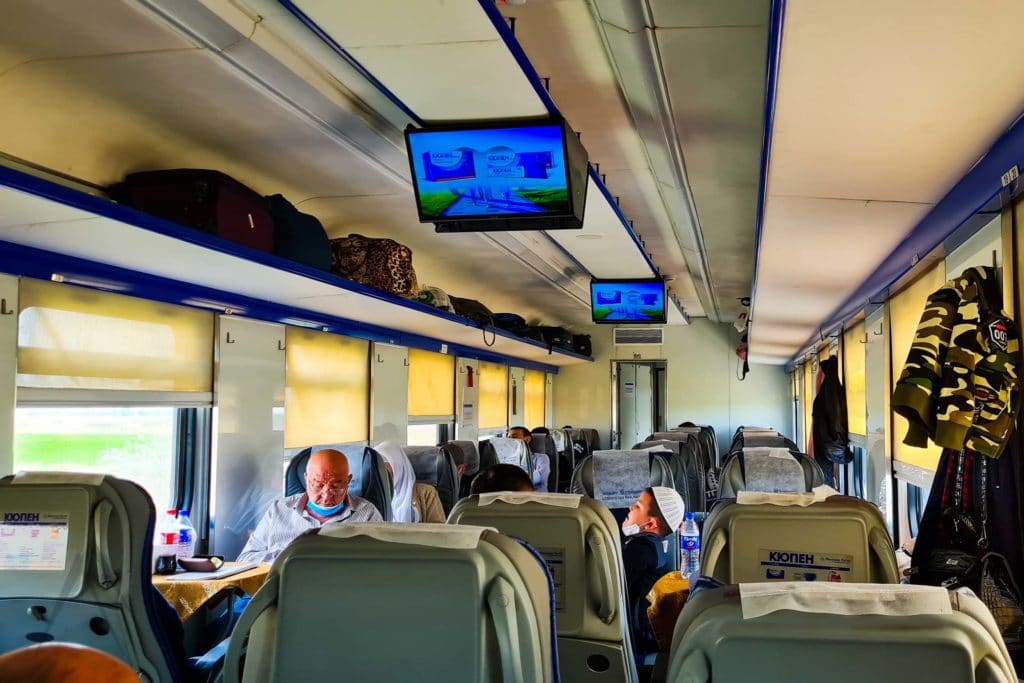
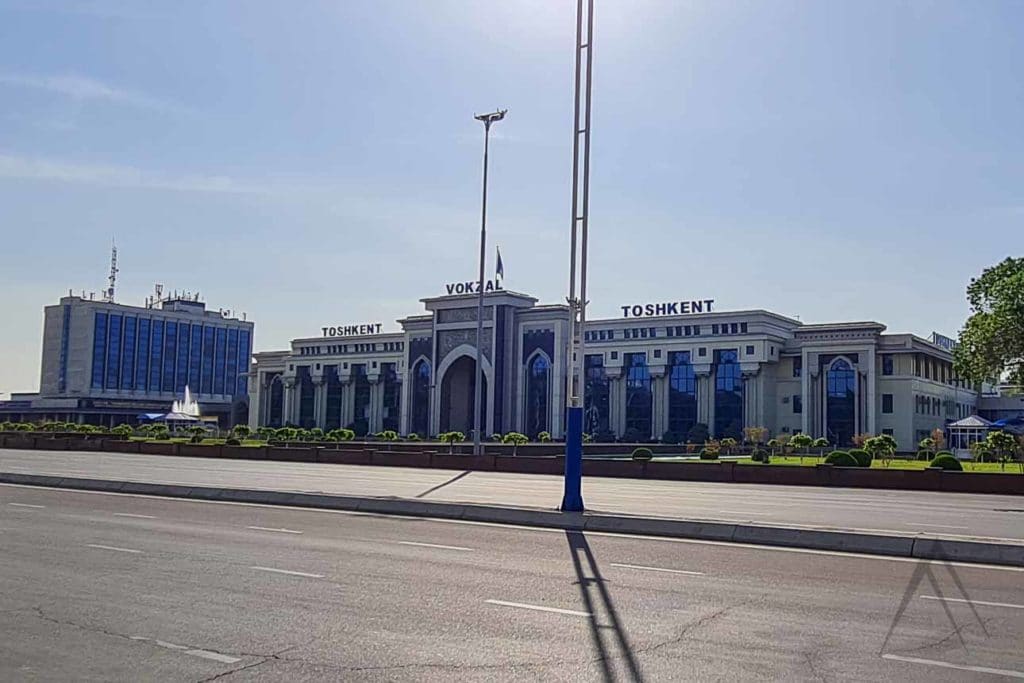
The Uzbekistan domestic train services are the best way to travel inside Uzbekistan with high speed trains but make sure to book your tickets in time as the high speed connections usually sell out early before the departure. The new trains are known as Afrosiab and they operate daily between Tashkent, Bukhara, Samarkand and Qarshi – Shahrisabz. The older trains usually take up to two times more time compared to Afrosiab.
The old trains travel also to Kokand, Margilan, Andijan, Urgench, Nukus, Kungrad, Atyrau (Kazakhstan), Termez, Denau and Sariasya. The latest addition to the rail network is the Khiva new train station. Check the latest information from the Railway.uz. Remember that the tickets bought online need to be changed at the station to the real (Soviet style) tickets before entering the train.
Tashkent by Bus / Taxi
You can get to Tashkent from any other major city in the neighboring cities and countries by bus, marshrutka, or by taxi. There are regular buses operated from Shymkent in Kazakhstan, Khujand in Tajikistan and from Bishkek, Kyrgyzstan as well (through Kazakhstan). Keep in mind that crossing the borders may take some time. The trip by bus or taxi may not be as comfortable as in the plane or train since many drivers save on air conditioning.
Tashkent has a number of bus stations and the station to go to depends on one’s destination. For long-distance routes it is better to book the tickets in advance as the scheduled buses fill up quickly. Shared taxis are usually spotted outside the bus stations and will move as soon as the car is filled with passengers.
Moving Around Tashkent
Public transport in Tashkent offers a fairly developed transport network. In recent years, the construction of a new metro line has begun and there are plans to extend the existing branches even further. Anyway, the metro forms the backbone of the public transportation with three lines. Check the up to date map from here. While you are moving around Tashkent with the metro take a note on the interiors of the metro stations. Each of them has their own character. The metro network is supplemented by an adequate number of buses and marshrutkas.
Yandex also works in Tashkent along with local taxi services. Tashkent is definitely a car-focused city but lately cycling paths or other cycling infrastructure have started to appear. Nevertheless, cycling in the Tashkent city, and even more in other cities of Uzbekistan, is more a leisure activity rather than a form of transport. The roads in Tashkent are in better condition compared to the regions and other capitals in Central Asia.
Tashkent Metro
Bus / Minibus in Tashkent
The bus service in Tashkent is much more extensive than the metro. Due to the recent population growth in the capital number of people have settled in the outskirts of the town. These areas are served mainly by buses, minibuses and taxis. The fare on buses in Tashkent is about 1400 sum which is almost the same as the fare on the subway. Mybus Tashkent is a useful application with real time data on buses, however it is only available in Russian and only for Android phones for now.
Taxi in Tashkent
Taxi fares around the city is usually between 10000 and 50000 sum depending on your destination. Yandex taxi started to operate in Tashkent in 2018. Nearby major transport facilities such as the railway stations, airport and even next to the metro stations, a bunch of private cabbies also offer their services almost around the clock. For safety reasons, it is worth giving preference to official carriers. Tashkent taxis, in general, are cheap. However, if you are taking a taxi waiting at the gates of the airport or next to the train station, it might be rather expensive so its better to check the price with the driver before starting your journey.
Sights & destinations near Tashkent
Page updated 15.11.2024